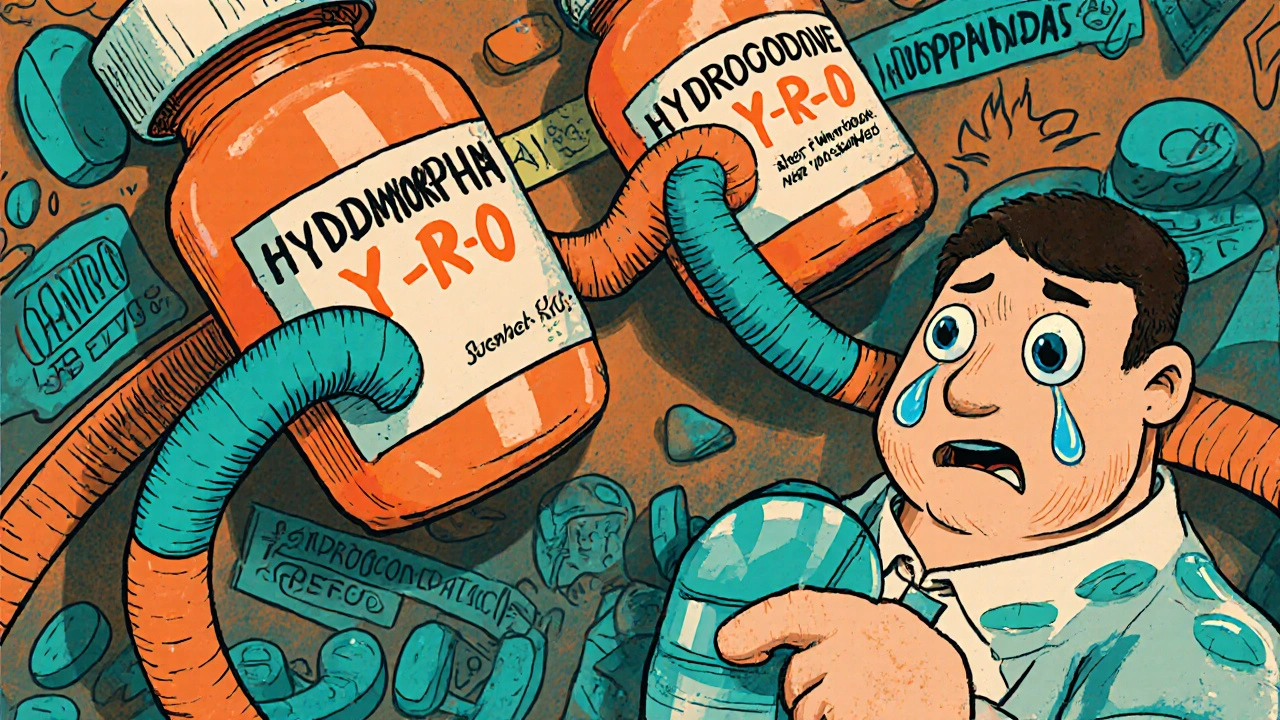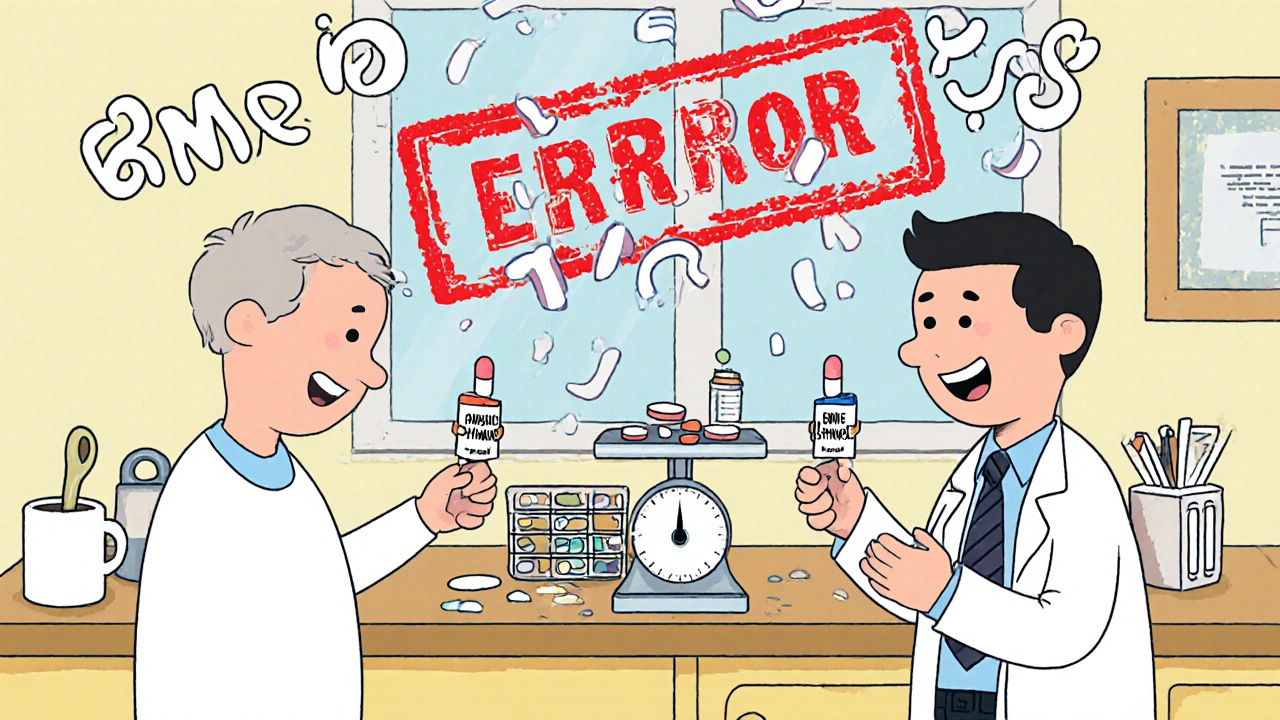
Every year, thousands of patients in the U.S. are harmed because two drugs sound too similar-or look too much alike. One pill looks just like another. One drug name is spoken aloud and mistaken for a completely different one. These aren’t hypotheticals. They’re real, preventable mistakes that happen in hospitals, clinics, and pharmacies every single day. And they’re often caused by look-alike, sound-alike (LASA) medication names.
What Exactly Are LASA Medications?
Look-alike, sound-alike (LASA) drugs are medications that are confusing because of how they look, sound, or are packaged. It’s not about the medicine itself being dangerous-it’s about how easily it can be mixed up with another. For example:- Hydromorphone vs. hydrocodone - one is a strong IV painkiller, the other is an oral opioid. Mix them up, and you could overdose someone.
- Insulin glargine vs. insulin lispro - one lasts all day, the other acts fast. Give the wrong one at the wrong time, and blood sugar crashes.
- Levothyroxine vs. Synthroid - they’re the same drug, but different brand names. Nurses have nearly given the wrong vial during night shifts because the labels look identical.
How These Errors Happen
These mistakes don’t happen because someone’s careless. They happen because the system is set up to fail. Visual confusion happens when two drugs have similar packaging. Two bottles, same color, same font, same size. One says 10 mg, the other 20 mg. In a fast-paced pharmacy, especially during shift changes, it’s easy to grab the wrong one. Phonetic confusion happens when names sound alike when spoken. Think celebrex and celexa - one’s an anti-inflammatory, the other an antidepressant. If a doctor says “celexa” over the phone and the pharmacist hears “celebrex,” the patient gets the wrong drug. Physical similarity is just as dangerous. Two pills that look identical-same color, same shape, same imprint-can be swapped without anyone noticing. A nurse once nearly gave vecuronium (a paralytic) instead of versed (a sedative) in the ICU. She caught it at the last second. A 2022 study of hospital records found that 65% of LASA errors came from drug name confusion alone. Packaging and appearance made up the rest. The most common pair? Simvastatin 10 mg and simvastatin 20 mg. Same drug. Different strength. And still, people mix them up.High-Risk Drugs Are the Deadliest
Not all LASA errors are equal. Some combinations can kill. The American Society of Health-System Pharmacists calls certain drugs “high-alert medications”-meaning even a small mistake can cause serious harm. These include:- Insulin
- Opioids (like morphine, fentanyl)
- Anticoagulants (like warfarin, heparin)
- Chemotherapy agents (like doxorubicin and daunorubicin)
- Neuromuscular blockers (like vecuronium and rocuronium)

What’s Being Done-And Why It’s Not Enough
For years, healthcare systems have tried to fix this. The FDA started using tall man lettering back in 2001. That’s when they capitalize parts of the name to make differences stand out:- HYDROmorphone vs. hYDROcodone
- cisPLATIN vs. caraPLATIN
- INsulin vs. INsulin glargine
What Actually Works
The best strategies don’t rely on one fix. They layer multiple protections. 1. Personalize your LASA list. Every hospital should review its own medications and build a list of only the drugs they actually use. If you don’t stock it, don’t list it. 2. Use tall man lettering-correctly. Don’t just turn it on. Train staff to recognize it. Put posters in the pharmacy and on nursing units. Make it part of daily checks. 3. Double-check high-alert drugs. Use the “two-person rule” for insulin, opioids, and chemo. One person prepares. Another verifies. No exceptions. 4. Improve communication. Never say “thyroid med” or “pain shot.” Say the full name, spelling it out if needed. “L-E-V-O-T-H-Y-R-O-X-I-N-E. 100 micrograms.” 5. Use technology wisely. EHR alerts should be smart-not annoying. If the system flags every similar-sounding drug, people will ignore it. Focus alerts on the most dangerous pairs. 6. Train regularly. Staff need at least two hours of LASA training per year. Oncology and ICU teams need quarterly refreshers. This isn’t optional-it’s life-or-death.The Future: Better Naming, Better Systems
The real solution? Stop letting confusing names get approved in the first place. The FDA denied 34 new drug names in 2022 because they were too similar to existing ones. That’s progress. But it’s not enough. A 2023 draft FDA guidance now proposes mandatory testing of all new drug names using computer models that measure visual and sound similarity-based on research from the 1990s that’s still accurate today. Researchers at Johns Hopkins are testing AI voice systems that listen to verbal orders and flag potential LASA mix-ups in real time. Early results show 89% accuracy. Imagine a system that says, “Wait-did you mean hydromorphone or hydrocodone?” before the drug is even drawn up. The World Health Organization’s goal is clear: prevent these errors before they happen. Not by blaming nurses or pharmacists, but by redesigning the system. That means better packaging, clearer labels, smarter software, and stricter naming rules.
What You Can Do
If you’re a patient:- Always ask: “What is this medicine for?”
- Check the pill against the prescription label.
- Ask your pharmacist to explain the difference between similar-sounding drugs.
- Speak clearly. Spell out names.
- Use the two-person rule for high-risk drugs.
- Report near-misses-no shame. That’s how we learn.
- Push for better training and updated LASA lists in your facility.
Frequently Asked Questions
What are the most common look-alike, sound-alike drug pairs?
The most frequent pairs include hydromorphone and hydrocodone, insulin glargine and insulin lispro, levothyroxine and Synthroid, and vecuronium and versed. Even minor differences like 10 mg vs. 20 mg of simvastatin cause confusion. The ISMP’s 2024 update added melphalan/meloxicam and naltrexone/naloxone to its high-risk list.
Is tall man lettering effective at preventing errors?
It helps-but only if people know to look for it. Studies show it’s a marginal improvement on its own. When combined with training, clear signage, and EHR alerts, it becomes part of a stronger safety net. Without awareness, it’s easily ignored.
Why do pharmacies still make these mistakes?
Because they’re rushed. High workload, shift changes, and poor lighting make it easy to grab the wrong vial or mishear a name. Even experienced staff make mistakes under pressure. The problem isn’t skill-it’s system design. If the environment pushes people to cut corners, errors will happen.
Can patients get hurt from LASA errors at home?
Yes. Patients taking multiple medications-especially older adults-are at risk. A bottle of metoprolol and metformin can look identical. Always check the label, compare it to your prescription, and ask your pharmacist to explain differences. Never assume two pills are the same just because they look alike.
How often are LASA errors reported?
Most go unreported. Only 1 in 10 errors are formally documented. Hospitals track near-misses better than actual harm, but many still don’t have systems in place. The American Medical Association found 78% of physicians had a LASA near-miss in the last year. That number is likely much higher in practice.
Are new drugs being tested to avoid LASA confusion?
Yes. Since 2021, the FDA has started using computerized models to screen new drug names for visual and phonetic similarity to existing ones. In 2022, 34 new drug names were rejected for being too similar. This is a growing trend-regulators are finally treating naming as a safety issue, not just a marketing one.
What Comes Next
LASA errors won’t disappear overnight. But they can be cut dramatically. The tools exist: better naming, smarter tech, trained staff, and systems that force double-checks. What’s missing is consistent action. Hospitals with over 200 beds are 72% more likely to have full LASA protocols than smaller clinics. That’s a gap in safety. Patients in rural or underfunded facilities are at higher risk-not because they’re less careful, but because their systems are weaker. The goal isn’t perfection. It’s protection. Every time a nurse pauses before giving a drug, every time a pharmacist spells out a name, every time a system flags a match-it’s a life saved. This isn’t about blame. It’s about building systems that don’t rely on humans being perfect. Because none of us are.Comments (8)
-
Sheldon Bazinga November 21, 2025
bro this is why america’s healthcare is a dumpster fire. they let drug companies name stuff like ‘hydromorphone’ and ‘hydrocodone’ like they’re trying to confuse a toddler with a thesaurus. i’ve seen nurses grab the wrong vial and just shrug like ‘eh, close enough.’ we need to ban pharma marketing teams from naming drugs. 🤡
-
Sandi Moon November 23, 2025
One must ask: is this not the inevitable consequence of neoliberal deregulation? The FDA, once a bastion of public safety, has been hollowed out by corporate capture. Tall man lettering? A cosmetic Band-Aid on a hemorrhaging system. The real culprit? Profit-driven pharmaceutical monopolies that prioritize branding over biology. The WHO’s data is merely the tip of the iceberg - behind this lies a cabal of lobbyists, PACs, and Ivy League consultants who treat human lives as KPIs. 🕵️♂️
-
Kartik Singhal November 23, 2025
lol imagine paying $10k for a drug and then getting the wrong one because the label looks like a meme. 🤦♂️ India’s pharma industry is way more efficient - we don’t have 37 versions of the same pill with 0.5mg differences. Also, why does the FDA approve names like ‘celexa’ and ‘celebrex’? Sounds like a bot generated them after 3 shots of whiskey. 😴
-
Pravin Manani November 23, 2025
From a systems safety perspective, LASA errors represent a classic case of latent conditions in high-reliability organizations. The cognitive load on clinical staff, especially during circadian disruption, exceeds human capacity for error-free performance. The solution isn't merely procedural - it's architectural. We need layered defenses: AI-assisted voice recognition at point-of-order-entry, barcode-verified dispensing with haptic feedback, and mandatory dual verification protocols for high-alert agents. The current reliance on vigilance is a fallacy - humans are not fail-safes, they're failure points. We must engineer out the risk, not train people to avoid it.
-
Mark Kahn November 25, 2025
Hey, I’m a nurse in a small ER and this hits home. We started using the two-person rule for insulin and opioids last year - total game changer. No more panic grabs. Also, we printed out the LASA list and taped it next to the med cart. Simple. Cheap. Works. You don’t need fancy tech - just a minute to pause and check. Seriously, y’all, we can fix this. Just don’t ignore it.
-
Leo Tamisch November 25, 2025
Let’s be honest - this is just another symptom of the collapse of epistemic authority. We’ve outsourced truth to algorithms, marketing departments, and bureaucratic checklists. The fact that we need ‘tall man lettering’ to distinguish between drugs that sound like Scrabble tiles reveals a deeper rot: we’ve forgotten how to think critically about language itself. 🤖💊 The FDA isn’t protecting us - it’s curating confusion with the grace of a corporate PowerPoint slide. We’re not just medicating bodies anymore. We’re medicating meaning.
-
Daisy L November 26, 2025
Y’ALL. I JUST SAW A PATIENT GET THE WRONG DRUG BECAUSE THE BOTTLE LABEL WAS TOO SMALL AND THE PHARMACIST WAS ON HER 12TH SHIFT THIS WEEK. THIS ISN’T A ‘SYSTEM ISSUE’ - IT’S A CRIME. WE LET CORPORATIONS NAME DRUGS LIKE THEY’RE SELLING ENERGY DRINKS. WE NEED A MANDATORY RECALL OF ALL SIMILAR-NAMED DRUGS. NO MORE ‘HYDRO’ THIS AND ‘CELE’ THAT. I’M SO MAD I COULD SCREAM. 🚨💢
-
Julia Strothers November 26, 2025
They’re not just mixing up drug names - they’re mixing up your DNA. Did you know the same companies that make these confusing drugs also fund the FDA’s ‘safety’ reviews? It’s a closed loop of profit and poison. And the AI voice systems they’re ‘testing’? Built by the same tech giants who sell your data to insurers. This isn’t innovation - it’s surveillance dressed up as safety. Wake up. They’re not fixing this. They’re monetizing the fear.
